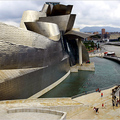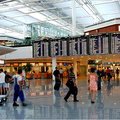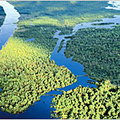
The Pousada Solar da Rede, in Mesão Frio, is an 18th-century manor house by the Douro River.
WE were driving south on Route 101 — a two-lane highway that slices diagonally through Portugal — in search of a tiny town called Mesão Frio and the Pousada Solar da Rede, an 18th-century manor house set above the Douro River. I had two maps spread out beside me, and a Spain-Portugal Michelin atlas open to the northern half of Portugal. How hard could it be to find the Douro? And where were we exactly? Lost somewhere, apparently in a nature preserve.
“Don't take the high-speed road,” a confident receptionist at the Pousada de Amares, where we'd stayed the night before, had assured us. “Route 101 is faster.” But one map showed Mesão Frio to the east, and the other to the west. “Just pick a direction!” urged my exasperated traveling companion as we hit what seemed to be our 40th unlabeled roundabout.
And then, suddenly, the pousada appeared — a mansion, Baroque and huge — after switchbacks and turns, looming high above the green Douro (finally!) about two hours upriver from Porto. It was an impressive sight: winged granite dragons guarding the path to the front door and a terraced, formal labyrinthine garden jutting out over a vineyard; bushes carved in circles and squares, flowers blooming everywhere; and the lovely Douro meandering like a Hudson River School painting, hazy in the near distance.
Akin to the state-owned Spanish paradores, the 65-year-old network of Portuguese pousadas (once entirely state-run, but now managed by the Pestana hotel group) range from 18th-century manor houses, like the one we'd been looking for, to former convents, monasteries, castles and palaces, as well as more modern buildings tucked into nature preserves and mountain ranges. They are almost all a challenge to get to — during our four-day trip in May, everyone my partner, Ian, and I spoke to had gotten lost at least once on the narrow roads that wrap around lush mountainsides where auto-routes inexplicably change names.
But any irritation over maps that don't coincide and towns that don't exist melts upon arrival. These buildings are magnificent: the ones we visited were as, if not more, beautifully turned out, we thought, than their Spanish counterparts.
Later that night, comfortably fed and checked in, we were finally able to laugh about our “one-hour” trip to Mesão Frio, which took nearly triple the time promised by Google Maps. We even recounted the story to our new friends and fellow guests, Claudia Dannhorn and Bruno Brawand, as we sat on embroidered damask chairs beneath a big crystal chandelier. Claudia sprinted back to her room and came back with a portable Global Positioning System. “You have to have one,” she said. “In Portugal there are no signs anywhere.” She pulled her legs underneath her, struggling to get comfortable — a real feat on chairs designed for ballerina-straight 18th-century postures.
This had been the formal family sitting room for a noble wine-estate family; their bewigged images adorn the traditional blue-tiled walls of the dining room. As with other manor houses in this region, these wealthy estate owners were producers of Douro wines — whites, reds and Ports — with 62 acres of family vineyards, along with orange and lemon trees.
The next morning we saw the grape vines and the fruit trees clinging to the sheer mountainside, spilling down to the meandering Douro itself. But that night it was stormy and dark, and the room was bright. Casual it is not. The chairs and love seats are the kind only Marie Antoinette might have found comfy: intricately carved, carefully embroidered. Just sitting in such a room — with its original 18th-century tiles on the walls and gilt French mirrors, straight-backed chairs and period silks everywhere — we felt as though we'd stepped over the red-velvet rope and were chilling out at Versailles. On a stand, a crumbling text in Portuguese provided the history of this family estate turned pousada.
In a gorgeously photographed coffee table book on the pousadas called “Moradas de Sonho” (which was translated as “Dream Places”), the pousadas are explained as the “preservation of [Portugal's] architectural and natural heritage, living architecture and the riches of Portuguese cooking.”
Solar da Rede's dining room — where local specialties like cabbage soup and roasted duck with a caramelized cherry reduction are served alongside such recent innovations as vegetarian crepes — was impressive, with Portuguese tiles and period chandeliers. In an environment of relaxed luxury, pousadas provide a glimpse of Portuguese history and landscapes, well off the traditional traveler's path.
Claudia and Bruno are just the type of visitor that Portugal hopes to entice as guests. The couple (she's German, he's Swiss) own and run the Hotel Berghaus Bort in the Swiss Alps town of Grindelwald, and they work without a day's rest, they told us, from November until May. Then, instead of sleeping, they travel for three weeks. One year it was Thailand. This year they were hopping from one pousada to the next, in large part because so many of their employees are Portuguese, and they wanted to get a taste of the country. Claudia and Bruno's journey began at the 12th-century Castelo de Óbidos, the first pousada converted from a historic building. They'd slept in the tower. And then they'd moved on to the medieval city of Guimarães, the entire downtown of which is a Unesco World Heritage site.
IF you drive in any direction from Guimarães — to the northern and eastern borders with Spain, or out to the Atlantic coast — the countryside is rich in pousadas: mostly convents and monasteries, each reflecting the austerity and isolation of this region in the Middle Ages. Many had fallen into terrible disrepair before adoption and rehabilitation by the pousada system. But the state of ruin, rather than complicating the restorations, allowed architects license for artistry, turning these buildings into places of the imagination as much as history.
Perhaps the best example of this is Santa Maria do Bouro, a monastery turned pousada just outside Amares, about 22 miles north of Guimarães. There I ran into J. Kasmin, a London-based retired art dealer, at the Pousada de Amares. Mr. Kasmin and his friend Peter Brock walked to the pousada, literally, at the end of a walking tour with On Foot Holidays— seven days of hiking in the Portuguese countryside. For the two, the effect of seeing the pousada through the mist was similar to that of the pilgrims who visited this monastery in the 14th century — that is, until the latter-day pilgrims stepped inside and found ancient walls transformed by modern art and design.
In the late 1980s Santa Maria do Bouro, a half-destroyed 12th-century monastery, was handed over to the Portuguese architect Eduardo Souto de Moura. He spent eight years on the restoration; the pousada was inaugurated in 1997.
The architect noted as he worked, “I am not restoring a monastery; I am building a pousada from the stones of a monastery.” The internal courtyard was left nearly a ruin, with trees growing from the rock and arches leading nowhere, visible through giant nonreflective glass windows along every corridor. Yet the rooms, once monks' cells, are modern and sleek, with all-white marble bathrooms. In the hallways, an oxidized iron ceiling hides air-conditioning and modern plumbing. Big windows have a view of a chapel attached to the monastery, seamlessly blending the old and new.
Downstairs, the restaurant walls are made entirely from ancient stones, stacked up to a ceiling three stories high. The original monastery ovens, giant and blackened, are set in back. Yet the tables are modern, with light wood chairs and cutlery so delicate and sensual it looks more like what you'd find at Georg Jensen than in a medieval dining room. The chef prepares local specialties like grilled octopus with “punched” potatoes (roasted and then squashed flat) and adds such innovations as vegetarian dishes and cilantro-infused rice.
Outside the restaurant, the view through five stone doorways to a closed antique green-painted wood door has caused many a diner to stop in wonder. Public sitting areas marry ancient and modern, with chestnut-colored leather chairs set against the 12th-century stones, and a huge fireplace near the bar. Large canvases of modern art feel at home in the space.
Outside the walls, it is a hike of two and a half miles to another medieval church; you can take a packed lunch from the kitchen. Most people head out by car, pointing their G.P.S. devices to the historic city of Guimarães, about 45 minutes away. The shell of the castle of Countess Mumadona Dias, considered to have been the most powerful woman in Portugal in the 10th century, is about a five-minute walk above the center of Guimarães. Today it is a playground for any child or adult who has ever liked stories about knights or princesses. It's exactly how you would imagine a castle should be, with a moat, a tower and parapets. Next door is the far better preserved 15th-century palace of the Dukes of Bragança, now a museum.
Guimarães's two pousadas are intertwined with the same kind of history. Downtown the Pousada Nossa Senhora da Oliveira faces the 14th-century church of Nossa Senhora da Oliveira and 15th-century nobles' homes on a medieval piazza, in the heart of the historic center. Wandering the streets here is as much a part of the charm as the pousada itself — 17th-, 18th- and 19th-century painted tiles adorn the walls; heavy wood beams serve as supports for the ancient buildings.
Set apart, a bit above the city, the other pousada — Santa Marinha — sits on a hillside. The grounds are magnificent, with a small stream ending in a tiny waterfall, well-maintained gardens and a large covered patio graced with 300-year-old tilework and a flowing stone fountain.
The day I visited, Inger Baehr, a retired Norwegian teacher, was sitting inside by windows overlooking the city, reading about the history of the pousada. Some years ago she and her husband reserved a room at this pousada as a respite after a conference in Lisbon. But they got lost, and arrived at 11 p.m. They were nevertheless so impressed they vowed to return to fully experience it. “We came back in January,” she said. “And now we're here with my 91-year-old mother, my brother and sister and their spouses.”
THE transition from Guimarães to the Solar da Rede pousada in Mesão Frio is dramatic, especially if you miss the high-speed autoroute and take the smaller national park road, as we did. The scenery is lush and verdant, hilly and vertiginous — you emerge from forest into vistas of endless grape vines and fruit-bearing trees. But nothing is more remarkable than the sheer geographic differences Portugal offers in such relatively short distances.
Leaving the Douro Valley after Solar da Rede, we headed toward the São Jacinto Nature Reserve on the Atlantic coast. On an isthmus less than an hour's drive south of Porto, the region resembles what the North Fork of Long Island must have looked like at the beginning of the last century. Farmland as far as the eye can see. Tractors. Oxen. (Oxen!) For every five tractors, a horse-drawn cart. From the bridge toward the small coastal town of Torreira and the nature reserve — a birder's paradise — the water is calm and blue; colorful moliceiro boats with upturned prows and sterns bobble in bunches near more modern motor boats; bicyclists in packs cruise the flat terrain.
After the monasteries and manor houses, we had a choice: another palace of some sort, or one of the “new” pousadas, built for their relation to nature rather than history. We opted for the latter: the Pousada de Torreira-Murtosa. Opened in 1967, it has the feel of a lovely summer house: cherry floors, faintly nautical décor, smart cream-and-maroon-mottled couches and sisal flooring. The building is airy — faintly reminiscent of Frank Lloyd Wright if you're being generous, or something designed by Mike Brady, the architect father from the Brady Bunch if you're being cheeky.
Nothing is meant to detract from the sea. Downstairs the wall is glass, the floor is slate. In the restaurant, overlooking a lagoon, the pousada offers local fish and seafood — cod, sardines, skate, octopus — with cracked olives. Since it's isolated in the nature preserve, there are no noisy neighbors, no sounds of motorboats, only water, fishermen in the distance and dunes nearby to climb on. We didn't even get lost on the way.
“Here you can recharge your batteries,” said the hotel manager, happy to try out an American idiomatic phrase. It would have been funny if it weren't so true.
VISITOR INFORMATION
GETTING THERE
In June, flights from Newark to Lisbon on Continental were running around $1,100 for July and August. From Lisbon, you must rent a car, as the pousadas are not accessible without one. Europcar has been offering a few specials for American citizens (from $202 for four days with unlimited mileage); Hertz has a similar price online. If you own a portable Global Positioning System device, this would be a good time to buy the European map system.
THE POUSADAS
On the central pousada Web site, www.pousadas.pt, descriptions are provided for each pousada; a map of the country, dotted with pousadas, gives a vague sense of the distances between them.
The Pestana hotel group, which manages the pousadas, recommends “routes” — like the “Port Wine Route,” “Lisbon and Route of the Castles,” the “Rice Route” and the “Cod Fishing Route” — but these names mean very little without a basic idea of Portuguese geography. You can combine pousada stays with visits to Porto, Lisbon or the Algarve by visiting the inns, which date from the 12th to the 20th centuries, along the way to your destinations.
The most economical way to visit the pousadas is to get a pousada “passport,” which costs 360 euros (about $485, at $1.35 to the euro) for a double room for four nights with a 35-euro supplement for Saturday evenings. There are rules for the passport — some pousadas won't take them during August, others charge a small additional fee — but for 11 months of the year, especially for midweek travel, the passport offers a significant savings over regular rates, which average 185 euros a night. Various other packages can be found at www.pousadasofportugal.com/passport.html.
Oddly, the central pousadas Web site and telephone number (351-21-844-20-01) were less forthcoming on discounts than the reception desks at the pousadas themselves. But check the site for “special offers” that vary from pousada to pousada.
Skipping the recommended “routes,” we tried the far north first, staying at the Pousada Santa Maria do Bouro (351-253-371-970), designed by Eduardo Souto Moura and opened in 1997, and then dipped down to Guimarães to check out the Pousada Nossa Senhora da Oliveira (351-253-514-157) in town and the Pousada Santa Marinha (351-253-511-249) above the town. We next drove down to the Douro River and spent the night at the Pousada Solar da Rede in Mesão Frio (351-254-890-130). For our last stop we tried a “new” pousada, the 40-year-old Pousada de Torreira-Murtosa (351-234-860-180), on the Ria Aveiro, across a wide seawater inlet from the town of Aveiro and set in a nature preserve. These hotels don't have street addresses. Instead the Web site provides a link to the Michelin-online map guide. I printed each of these, but still found myself lost all the time.
DINING
The regional cuisine is reflected on the menus, and with the pousadas passport we had two 20 percent discount coupons for dinner. Perhaps our best dining experience was at the Pousada de Torreira-Murtosa, on the water, with its fresh fish and ceviche starters. Off the pousada route, around the corner from the Pousada Nossa Senhora da Oliveira, in Guimarães, we found Val-Donas (Rua de Val Donas 4; 351-253-511-411; www.valdonas.com), a lovely modernist space with whitewashed walls and black-and-white photographs. The menu is local — fish, cabbage soup — but reasonable. Dinner for two with wine comes to about 45 euros.
WINERIES
Near the Pousada Solar da Rede, in the Douro Valley, you can visit small wineries like Quinta de la Rosa (Pinhão; 351-254-732-254; www.quintadelarosa.com), which is also a small bed-and-breakfast; Quinta Nova (Pinhão; 351-254-730-430); and the larger Caves Sandeman (Largo Miguel Bombarda 3, Vila Nova de Gaia; 351-223-740-500; www.sandeman.com).






